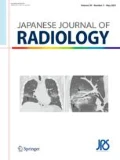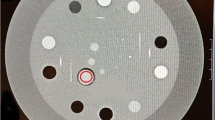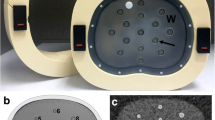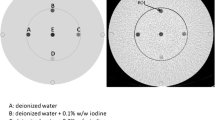Abstract
Purpose
The aim of this study was to validate the use of a calibration factor measured outside the object for estimating the iodine concentration inside the object to improve the accuracy of the quantitative contrastenhanced computed tomography (CT).
Materials and methods
Several known concentrations (0, 6, 9, and 12 mg I/ml) of iodine contrast material (CM) samples were placed inside and outside cylindrical acrylic phantoms of two sizes and were imaged under various combinations of the tube voltages and currents (kV/mAs–80/200, 100/200, 120/200, 140/200) to obtain K factors. The K factors were compared between the phantoms and among the tube voltages. Each CM concentration was estimated from the CT number using the K factor measured outside the phantom.
Results
The K factors varied between the phantoms or among the tube voltages (P < 0.05). Although there were statistically significant variations in K factors among the different regions in a phantom, the mean variation coefficient was 3%–4%. The mean error of the estimated concentration was −5.5%.
Conclusion
The CM concentration should be accurately estimated at the region within a patient’s body using the K factor measured at the surface of the body regardless of body size and tube voltage.
Similar content being viewed by others
References
Pastorino U, Bellomi M, Landoni C, De Fiori E, Arnaldi P, Picchio M, et al. Early lung-cancer detection with spiral CT and positron emission tomography in heavy smokers: 2-year results. Lancet 2003;362:593–597.
Szolar DH, Kammerhuber F. Quantitative CT evaluation of adrenal gland masses: a step forward in the differentiation between adenomas and nonadenomas? Radiology 1997;202:517–521.
Boland GW, Hahn PF, Pena C, Mueller PR. Adrenal masses: characterization with delayed contrast-enhanced CT. Radiology 1997;202:693–696.
Swensen SJ, Brown LR, Colby TV, Weaver AL, Midthun DE. Lung nodule enhancement at CT: prospective findings. Radiology 1996;201:447–455.
Tateishi U, Nishihara H, Watanabe S, Morikawa T, Abe K, Miyasaka K. Tumor angiogenesis and dynamic CT in lung adenocarcinoma: radiologic-pathologic correlation. J Comput Assist Tomogr 2001;25:23–27.
Miles KA. Measurement of tissue perfusion by dynamic computed tomography. Br J Radiol 1991;64:409–412.
Miles KA, Griffiths MR. Perfusion CT: a worthwhile enhancement? Br J Radiol 2003;76:220–231.
Nakayama Y, Awai K, Funama Y, Hatemura M, Imuta M, Nakaura T, et al. Abdominal CT with low tube voltage: preliminary observations about radiation dose, contrast enhancement, image quality, and noise. Radiology 2005;237:945–951.
Miles KA, Young H, Chica SL, Esser PD. Quantitative contrast-enhanced computed tomography: is there a need for system calibration? Eur Radiol 2007;17:919–926.
Siegel MJ, Schmidt B, Bradley D, Suess C, Hildebolt C. Radiation dose and image quality in pediatric CT: effect of technical factors and phantom size and shape. Radiology 2004;233:515–522.
Garrett JS, Lanzer P, Jaschke W. Measurement of cardiac output by cine computed tomography. Am J Cardiol 1985;10:657–661.
Ludman PF, Darby M, Tomlinson N, Poole-Wilson PA, Rees S. Cardiac flow measurement by ultrafast CT: validation of continuous and pulsatile flow. J Comput Assist Tomogr 1992;16:795–803.
Welch BL. The generalization of “Student’s” problem when several different population variances are involved. Biometrika 1947;34:28–35.
Neuhäuser M. Two-sample tests when variances are unequal. Anim Behav 2002;63:823–825.
Zerhouni EA, Spivey JF, Morgan RH, Leo FP, Stitik FP, Siegelman SS. Factors influencing quantitative CT measurements of solitary pulmonary nodules. J Comput Assist Tomogr 1982;6:1075–1087.
Birnbaum BA, Hindman N, Lee J, Babb JS. Multi-detector row CT attenuation measurements: assessment of intra-and interscanner variability with an anthropomorphic body CT phantom. Radiology 2007;242:109–119.
Author information
Authors and Affiliations
Corresponding author
About this article
Cite this article
Takanami, K., Higano, S., Takase, K. et al. Validation of the use of calibration factors between the iodine concentration and the computed tomography number measured outside the objects for estimation of iodine concentration inside the objects: phantom experiment. Radiat Med 26, 237–243 (2008). https://doi.org/10.1007/s11604-007-0220-9
Received:
Accepted:
Published:
Issue Date:
DOI: https://doi.org/10.1007/s11604-007-0220-9




